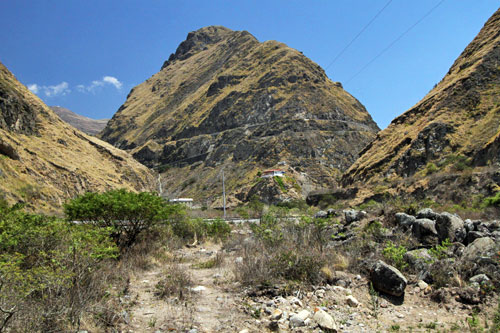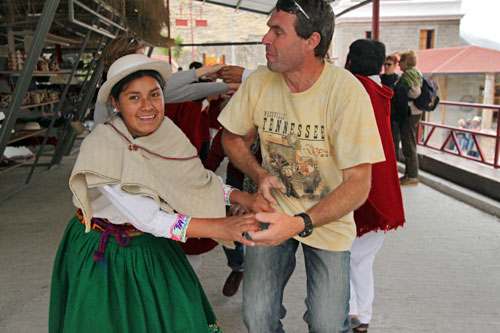High in the Andes Mountains, at the point where the Guasuntos and Chanchán Rivers meet, a gigantic rock known as El Nido del Condor (Nest of the Condor) soars more than 6,200 feet. I sat atop this massif, safely ensconced in a leather seat on board what has been dubbed “the most difficult railroad in the world,” acutely aware that I owed my comfort to those who had perished in its construction. As the vintage diesel locomotive chugged slowly down the steep slope, belching black smoke and causing my wooden carraige to rock to and fro in time with the clickety-clack wheels, my thoughts turned to the reasons this famous ride is named “La Nariz del Diablo,” the Nose of the Devil.

Construction of the line between the southern coast and Quito began in 1871 in the lowlands near Guayaquil but three years later, only 7.6 miles had been completed. Plagued with theft of construction materials, lack of funding, political bickering, debilitating tropical diseases, floods and landslides, efforts were finally abandoned in 1888 with only 65 miles completed. Ten years later, Ecuador turned to the United States for help. Brothers John and Archer Harman were hired and work resumed. Mile after backbreaking mile was slowly completed until the line reached El Nido del Condor. In two miles, the train would need to ascend more than 5,700 feet but unlike the majestic birds for which the monolithic rock is named, trains could not sprout wings and fly down its face.
Can’t view the above slide show about the Nariz del Diablo (Nose of the Devil) Train ride in Alausi, Ecuador? Click here.
The solution was a unique zig-zag track design that allows trains to climb the steep grade as far as possible to a terminus, reverse direction and back up a subsequent section of track to a second terminus, then move forward again on a final section of ascending tracks. Hundreds of Jamaican slaves who were brought in to dynamite the hard rock lost their lives in the process; they, along with scores who succumbed to malaria, yellow fever, and poisonous snakes remain entombed in the rubble along the route, earning it the nickname La Nariz del Diablo by the time it finally opened between the coast and Alausi in 1901.
We chugged to a stop at the foot of the Nose of the Devil for a look back at the nearly vertical wall we had just descended. Tracks cut diagonally into the side of the mountain grinned down on us diabolically. A few minutes further down the line we reached our final destination, Sibambe, where we stopped for lunch. I lagged behind the other passengers, preferring instead to watch the locomotive uncouple and switch to the other end of the train in preparation for our return trip before visiting the excellent displays on indigenous Quechua/Kichua culture at the Cóndor Puñuna Museum and enjoying a performance of traditional dances. Too soon, the train whistle signaled our departure and I climbed aboard for the return to Alausi.
Though the tracks continue south, the floods of 1997-98 washed out sections and the railroad today ends in Sibambe. Ecuador’s President Correa recently committed to repair the tracks by 2013, bringing back the heyday of railroad travel, when passengers could ride from Quito to Guayaquil. In the meantime, taking the three hour round-trip down the Devil’s Nose is well worth the time. After all, it’s the journey that counts, not the destination.

How to Ride the Nariz del Diablo Train
Round-trip tickets for the Alausi-Sibambe-Alausi route are $20 and can be purchased at any of the train offices that are maintained in major tourist spots around Ecuador, or by calling 1-800-TRENES (873637). There is also an Ecuador Railway office on the corner of Eloy Alfaro and Sucre in Alausi; be sure to go in the morning as it sometimes closes at 2 p.m. Breakfast/lunch at the Train Cafe in Sibambe is included in the price, as is entrance to the on-site museum.
Most of the scenery is on the right-hand side of the train. Though passengers are asked to switch sides on the return trip so that everyone will see the best scenery, I strongly suggest asking for a right-hand seat, since the skies and valleys often cloud up later in the day. Currently the Nariz del Diablo route operates Tuesday through Sunday and holidays, with departures at 8 a.m., 11 a.m., and 3 p.m. If intending to travel in high season, it is a good idea to make advance reservations, as the trains often fill up a week in advance. In past years, passengers were allowed to ride on top of the train, however a few years ago two Japanese passengers were decapitated while riding atop and since that time riding on top has been prohibited.

Hi, I was wondering if you have more info of the Japanese who were decapitated or further details of what happened, their names…or possibly who might have more info.
I was hung on 10th July, 2006 on this train. As the train was so full I was pinned down, stretched till my body started being pulled apart. My glut medious was ripped completely off of my hip bone, my L4-L5 was 60% herniated, thumb was shredded and it also triggered autoimmune illnesses. It has destroyed my life, utterly. Left me sick and constantly paining.
However, I feel utterly culpable as I didn’t make a fuss about what happened to me…like a coward I just ran away and took care of myself. If I had done the right thing they would probably still be alive…as a person who has protested and taken action the world over I am disgusted that the one time my actions could have actually saved a life…instead I missed the chance and 2 innocents paid the price…one year, almost to the day, after my hanging. I am grateful for whatever clues you may have. As I am getting sicker, I need to face the family of those that died and apologize before I leave this life.
thank you for your help. Robin Hamm
I’m sorry Robin, but I have no additional information about the Japanese tourists who were killed. So sorry to hear about your horrible experience. I do hope you find a way to forgive yourself, as it doesn’t sound to me like you were in any way responsible. Though you may not have complained, those Japanese tourists made a decision to sit on the roof, and they did not watch for hazards during the trip. You are certainly not responsible for any of those actions. Sending prayers for your health.
I love that your writing not only tempts travellers to explore further, but also offer such a fabulous education as to culture and history of the region- including those whose lives were lost in its development.
Awesome article! I am planning to go to Ecuador, this place I think its a MUST SEE! so I make some plans to visit Alausi after my Galapagos Cruise
That looks like one heck of a train ride and great photos !!
the information and photos are beautiful. I traveled to Galapagos Islands in Ecuador and is amazing.
Wow, just reading through this blog gave me a different type of Mexican adventure. 😛
This is not Mexico. Not everything south of the US is Mexico ffs.
Thanks for the info on how to take the trip. I’m heading to Ecuador in a few weeks and was considering taking the ride.
Beautiful photos! You make the Nose of the Devil seem a lot less threatening.
Your articles are always packed full of info. Thanks for sharing.